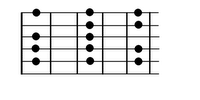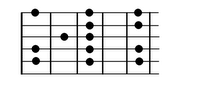Everyone who reads this blog and is free next week should come out to see me as the feature performer at Amazing Things next Thursday 10/19. Even though the bio is talking about someone else, trust me, I am really the feature!
I am looking forward to participating in a guitar workshop given by David Surette later this month at ArtSpace in Greenfield, MA. It should be good - I've heard David's work on the web and on a CD/Book called Pierre Bensusan presents DADGAD music, which features many great players, including Brooks Williams and Phil Keaggy, two of my personal favorites.
A while back I mentioned working out the diatonic scale patterns in DADGAD tuning. I'll give some of my thoughts and maybe a diagram or two here:
The first thing that sticks out at one when trying to work this out, is the two places where intervals between strings diverge from standard tuning (6->5 and 3->2). The 5th from 6->5 is a difficult problem, since it presents quite a stretch to acheive a half-tone or whole-tone interval especially at the lower frets. This problem is easiest solved through the use of the open 'A' string. This solution is unfortunately specific to key (and not applicable to every key), so I'll circle back at some point to address it. For now, I'll deal with moveable forms where the tonic is located on the 5th ('A') string.
The 3->2 whole-tone is much easier to deal with, and in terms of melody arrangement, is one of the reasons DADGAD is such an interesting tuning to play in. The 3->2 transition sorts the scale patterns into two groups, based on whether there is a half-tone or whole-tone interval at the point in the scale where one crosses from the 3rd to 2nd string.
There are two modes where this transition is a half-tone:
Locrian mode:

The remaining five modes all place a whole-tone interval between the 3 and 2 strings:
Mixolydian: mmmmmmmmmLydian: mmmmmmmmmmAeolian:



Dorian:mmmmmmmmmmm Ionian:


A close inspection reveals there are two approaches present for playing across the third and second strings: the most common taken above is to use adjacent fingers (with a bit of a stretch - if you are serious about DADGAD, get used to it!) to play the interval on the same fret; this is used in all but the Aeolian (or minor) mode where a bar of the first finger is used instead. A quick analysis will reveal that this approach is also valid for the Dorian and Mixolydian modes but will not work with Ionian or Lydian at all. Conversely, the two-finger adjacent string approach used in all the other modes may easily be applied to Aeolian as well.
So, if you're so inclined, play around with these patterns, combine them into Segovia-style scale exercises with one or more position changes, get comfortable with all the modes of a single major key. In a future installment of esoteric DADGAD fretboard analysis I'll delve into the topic of dealing with that nasty 5th between the 6 and 5 strings, and perhaps even go into scales played "harp style" with maximum use of adjacent strings (DADGAD lends itself especially well to this use).
Enjoy! And come out next Thursday to see me play!

The remaining five modes all place a whole-tone interval between the 3 and 2 strings:
Mixolydian: mmmmmmmmmLydian: mmmmmmmmmmAeolian:



Dorian:mmmmmmmmmmm Ionian:


A close inspection reveals there are two approaches present for playing across the third and second strings: the most common taken above is to use adjacent fingers (with a bit of a stretch - if you are serious about DADGAD, get used to it!) to play the interval on the same fret; this is used in all but the Aeolian (or minor) mode where a bar of the first finger is used instead. A quick analysis will reveal that this approach is also valid for the Dorian and Mixolydian modes but will not work with Ionian or Lydian at all. Conversely, the two-finger adjacent string approach used in all the other modes may easily be applied to Aeolian as well.
So, if you're so inclined, play around with these patterns, combine them into Segovia-style scale exercises with one or more position changes, get comfortable with all the modes of a single major key. In a future installment of esoteric DADGAD fretboard analysis I'll delve into the topic of dealing with that nasty 5th between the 6 and 5 strings, and perhaps even go into scales played "harp style" with maximum use of adjacent strings (DADGAD lends itself especially well to this use).
Enjoy! And come out next Thursday to see me play!


No comments:
Post a Comment